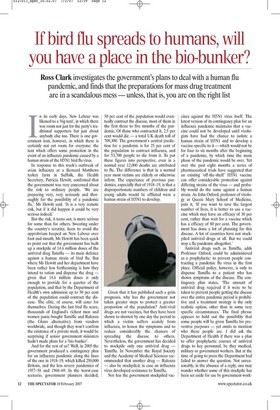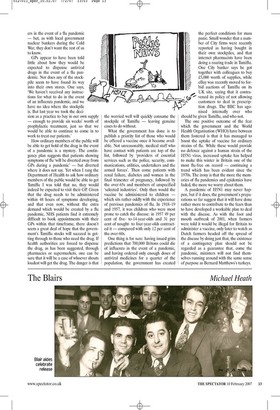If bird flu spreads to humans, will you have a place in the bio-bunker?
Ross Clark investigates the government's plans to deal with a human flu pandemic, and finds that the preparations for mass drug treatment are in a scandalous mess — unless, that is, you are on the right list 1 n its early days, New Labour was likened to a 'big tent', in which there was room not just for the party's traditional supporters but just about anybody else too. There is one government tent, however, in which there is certainly not yet room for everyone: the tent which offers some protection in the event of an influenza pandemic caused by a human strain of the H5N1 bird flu virus.
In response to this week's outbreak of avian influenza at a Bernard Matthews turkey farm in Suffolk, the Health Secretary, Patricia Hewitt, confirmed that the government was very concerned about the risk to ordinary people. 'We are preparing very, very seriously and thoroughly for the possibility of a pandemic flu,' Ms Hewitt said. 'It is a very remote risk, but if it did happen it could be very serious indeed.'
But the risk, it turns out, is more serious for some than for others. Sweating under the country's scrutiny, keen to avoid the opprobrium heaped on New Labour over foot and mouth, Ms Hewitt has been quick to point out that the government has built up a stockpile of 14 6 million doses of the antiviral drug Tamiflu — its main defence against a human strain of bird flu. But where Ms Hewitt and her department have been rather less forthcoming is how they intend to ration and dispense the drug — given that 14.6 million doses is only enough to provide for a quarter of the population, and that by the Department of Health's own admission up to 50 per cent of the population could contract the disease. The elite, of course, will cater for themselves. During the last bird flu scare, thousands of England's richest men and women panic-bought Tamiflu and Ralenza (the Glaxo alternative) from vendors worldwide, and though they won't confirm the existence of a private stash, it would be surprising if senior government ministers hadn't made plans for a `bio-bunker'.
And for the rest of us? Well, in 2005 the government produced a contingency plan for an influenza pandemic along the lines of the one in 1918-19, which killed 250,000 Britons, and the less severe pandemics of 1957-58 and 1968-69. In the worst-case scenario, government planners decided, 50 per cent of the population would eventually contract the disease, most of them in the first three to five months of the pandemic. Of those who contracted it, 2.5 per cent would die — a total UK death toll of 709,300. The government's central prediction for a pandemic is for 25 per cent of the population to contract influenza, and for 53,700 people to die from it. To put these figures into perspective, even in a normal year 12,000 deaths are attributed to flu. The difference is that in a normal year most victims are elderly or otherwise infirm. The experience of previous pandemics, especially that of 1918-19, is that a disproportionate numbers of children and young adults would be afflicted were a human strain of H5N1 to develop.
Given that it has published such a grim prognosis, why has the government not taken greater steps to protect a greater proportion of the population? Anti-viral drugs are not vaccines, but they have been shown to shorten by one day the period in which a victim suffers acutely from influenza, to lessen the symptoms and to reduce considerably the chances of spreading the disease to others. Nevertheless, the government has decided to stockpile only one antiviral drug — Tamiflu. In November the Royal Society and the Academy of Medical Sciences recommended that another drug — Ralenza — also be stockpiled, in case an influenza virus developed resistance to Tamiflu.
Nor has the government stockpiled vaccines against the H5N1 virus itself. The latest version of its contingency plan for an influenza pandemic maintains that a vaccine could not be developed until virologists have had the chance to isolate a human strain of H5N1 and to develop a vaccine specific to it — which would not be for four to six months after the beginning of a pandemic, by which time the main phase of the pandemic would be over. Yet over the past eight months a series of pharmaceutical trials have suggested that an existing 'off-the-shell H5N1 vaccine can offer considerable protection against differing strains of the virus — and probably would do the same against a human strain. As John Oxford, professor of virology at Queen Mary School of Medicine, puts it, 'If you want to save the largest number of lives, it is better to use a vaccine which may have an efficacy of 30 per cent, rather than wait for a vaccine which has a efficacy of 80 per cent. The government has done a lot of planning for this disease. A lot of countries have not stockpiled antiviral drugs at all. But we could stop a flu pandemic altogether.'
Antiviral drugs such as Tamiflu, adds Professor Oxford, could be administered as a prophylactic: to prevent people contracting a pandemic flu virus in the first place. Official policy, however, is only to dispense Tamiflu to a patient who has shown symptoms of the disease. The contingency plan states, 'The amount of antiviral drug required if it were to be taken to prevent people getting the disease over the entire pandemic period is prohibitive and a treatment strategy is the only realistic option, other than in some very specific circumstances.' The final phrase appears to hold out the possibility that some people will be given Tamiflu for preventive purposes — yet omits to mention who these people are. I did ask the Department of Health if there was a plan to offer prophylactic courses of antiviral drugs to key personnel, be they medical, military or government workers. But at the time of going to press the Department had failed to answer the question. Not unreasonably, in the absence of a reply, one may wonder whether some of this stockpile has been set aside for use by government workers in the event of a flu pandemic — but, as with local government nuclear bunkers during the Cold War, they don't want the rest of us to know.
GPs appear to have been told little about how they would be expected to dispense antiviral drugs in the event of a flu pandemic. Nor does any of the stockpile seem to have found its way into their own stores. One says, 'We haven't received any instructions for what to do in the event of an influenza pandemic, and we have no idea where the stockpile is. But last year we took the decision as a practice to buy in our own supply — enough to provide six weeks' worth of prophylactic treatment, just so that we would be able to continue to come in to work to treat our patients.'
How ordinary members of the public will be able to get hold of the drug in the event of a pandemic is a mystery. The contingency plan suggests that patients showing symptoms of flu 'will be diverted away from GPs during a pandemic' — but diverted where it does not say. Yet when I rang the Department of Health to ask how ordinary members of the public would be able to get Tamiflu I was told that no, they would indeed be expected to visit their GP Given that the drug needs to be administered within 48 hours of symptoms developing, and that even now, without the extra demand which would be created by a flu pandemic, NHS patients find it extremely difficult to book appointments with their GPs within that timeframe, there doesn't seem a great deal of hope that the government's Tamiflu stocks will succeed in getting through to those who need the drug. If health authorities are forced to dispense the drug, as has been suggested, through pharmacies or supermarkets, one can be sure that it will be a case of whoever shouts loudest will get the drug. The danger is that the worried well will quickly consume the stockpile of Tamiflu — leaving genuine cases to do without.
What the government has done is to publish a priority list of those who would be offered a vaccine once it became available. Not unreasonably, medical staff who have contact with patients are top of the list, followed by 'providers of essential services such as the police, security, communications, utilities, undertakers and the armed forces'. Then come patients with renal failure, diabetes and women in the final trimester of pregnancy, followed by the over-65s and members of unspecified 'selected industries'. Only then would the vaccine be administered to children — which sits rather oddly with the experience of previous pandemics of flu. In 1918-19 and 1957, it was children who were most prone to catch the disease: in 1957 49 per cent of fiveto-14-year-olds and 31 per cent of noughtto four-year-olds contracted it — compared with only 12 per cent of the over-60s.
One thing is for sure: having issued grim predictions that 700,000 Britons could die of influenza in the event of a pandemic, and having ordered only enough doses of antiviral medicines for a quarter of the population, the government has created the perfect conditions for mass panic. Small wonder that a number of City firms were recently reported as having bought in their own stockpiles, and that internet pharmacists have been doing a roaring trade in Tamiflu. One City banker says he got together with colleagues to buy £5,000 worth of supplies, while eBay was recently moved to forbid auctions of Tamiflu on its UK site, saying that it contravened its policy of not allowing customers to deal in prescription drugs. The BBC has agonised internally over who should be given Tamiflu, and who not.
The one positive outcome of the fear which the government and the World Health Organisation (WHO) have between them fostered is that it has managed to boost the uptake of vaccine for ordinary strains of flu. While these would provide no defence against a human strain of the H5N1 virus, increased uptake has helped to make this winter in Britain one of the most flu-free on record — continuing a trend which has been evident since the 1970s. The irony is that the more the memories of flu pandemics and epidemics have faded, the more we worry about them.
A pandemic of H5N1 may never happen, but if it does, the government's preparations so far suggest that it will have done rather more to contribute to the fears than to have developed a workable plan to deal with the disease. As with the foot and mouth outbreak of 2001, when farmers were told it would be illegal for Britain to administer a vaccine, only later to watch as Dutch farmers headed off the spread of the disease by doing just that, the existence of a contingency plan should not be regarded as a guarantee that, come the pandemic, ministers will not find themselves running around with the same sense of purpose as Bernard Matthews's turkeys.














































 Previous page
Previous page